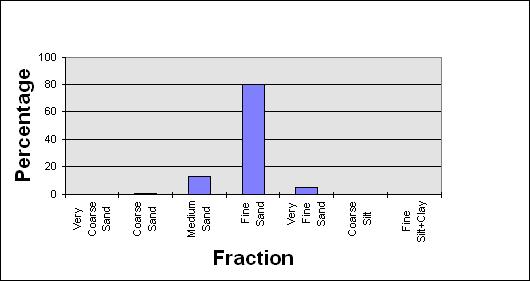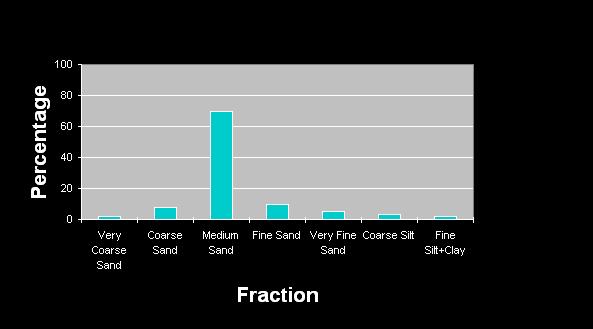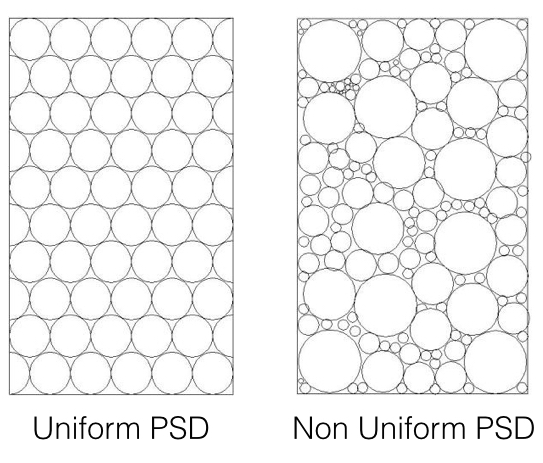In the first part of this series we discovered that the ideal bowling green soil (or rootzone) will be 50% space, 5% organic matter, with the remainder (45%) being made up of mineral matter, namely Sand, Silt and Clay. These are the 3 universal mineral components of soil. Part 1 finished with an explanation of the soil fractions, 5 of which were sands of varying sizes.
In part 2 we found out a little bit more about sand and it’s behaviour as a drainage medium and we discovered a little more about how soils are formed. We finished by looking at the importance of sand particle shape and size in bowling green rootzones.
Clay
We are all familiar with clay as a substance in many different aspects of our lives. It’s used to make bricks, pottery and for modelling. If you’ve ever moved to a newly built house you will doubtless have encountered the problem of trying to make a decent garden out of the heavy clay soil that builders seem to carry around for the purpose of making your life difficult; or is it that all new houses are built in areas where there is heavy clay soil? Regardless of the solution to that conundrum, we often think of clay as big, chunky, unmanageable clods of red earth. The fact is though, that those whopping clods are actually made up of the tiniest of particles in the soil, less than 2 thousandths of a millimetre in diameter.
Fines
Along with silt particles, which are relative giants at up to 5 hundredths of a millimetre in diameter, clay and the very fine sand fraction (0.05-0.10mm) make up what is known as the Fines in the soil. The fines are very important in any rootzone mix, because they are largely responsible for dictating the soil’s ability to provide water and nutrients to our grass plants. This doesn’t mean, however, that more fines make a better soil, it just means that we need to be very aware of the balance of fines to the other 4 sand fractions. The measure of this spread of particles in any soil or rootzone sample is called the Particle Size Distribution or PSD for short.
High performance rootzones will typically have no more than 10% of the particles in the Fines category. Remember that we are only measuring the mineral element of the soil. For PSD Analysis, all of the organic material is burned off before the dried mineral component is shaken through a series of graded sieves and measured.
Particle Size Distribution (PSD)
In my introduction to this series of articles, I said that an understanding of Bowls Green Soil Texture, was probably the single most important piece of knowledge a greenkeeper can have as it impacts on almost everything else in bowling green maintenance. Well, I can probably refine that statement to simply Greenkeepers must understand PSD. Particle Size Distribution really encapsulates the knowledge of soils that greenkeepers would do well to have in their heads ready for instant recall. This knowledge can help you work out just about anything else that you need to know about the performance of your bowling green. But what is PSD? Have a look at the charts below:


Links
The upper chart shows the PSD for a typical (natural) soil on the links land on the East Coast of Scotland. It’s actually from a very famous golf course. The first thing we notice is that 80% of the particles are in a single fraction, in this case Fine Sand. This is typical of links soils. You will recall from part 2 of this series that beach sand is graded by the wind with the finest particles being blown furthest from the shore. The perfect balance of PSD for the formation of tight knit, dense bent and fescue turf just happens to be found on the Links land that we find around much of the UK. In this example, the mineral element of the Links soil is made up of 80% of the Fine Sand fraction, or sand particles falling between 0.10 and 0.25 mm in diameter. You will also notice the Fines are made up almost entirely of Very Fine Sand, with Clay and Silt barely registering on this graph. Again this is typical of Links soils, as the mineral element is almost entirely made of sand, weathered down from seashells.
USGA
In the second graph we can see a typical PSD analysis for a manufactured rootzone material for a USGA (United States Golf Association) Specification golf green. Again you will see a very large percentage of the particles falling in one fraction. This time around 70% of the sample is made up of Medium Sand (0.25-0.5mm). In this case because we are working with a quarried sand material, the fines contain some silt and clay, but the 3 fines combined still make up less than 10% of the rootzone. Incidentally, the reason for specifying Medium Sand in such rootzone materials is to do with Soil Hydraulics (water movement) and the need to build greens economically. The natural links soil might be several feet deep, where as the manufactured green will have no more than 12inches of soil depth. This creates a need for a greater gravitational pull in order to maintain drainage performance. The bigger aeration pores created by Medium Sand means that a 12 inch deep soil can perform as well as a 2 or 3 feet deep soil predominantly made up of Fine Sand.
PSD and Drainage.
The benefit of having a very uniform (70-80% falling in one fraction) sand in the rootzone mix is that it creates a lot of air space in the soil. Remember we talked about the woes of trying to build a sand castle with the ever shifting sand near the dunes? Uniformity in terms of particle size creates air spaces and makes the sand very mobile and resistant to packing down. The air spaces (macro-pores) in the soil are where the oxygen is kept in the soil to help nurture a big population of soil microbes and is also where the drainage occurs. Excess water is pulled through the rootzone by gravity and drained away.
PSD and Moisture Retention
Of course, if we had a rootzone that was too uniform in PSD, then our bowling greens would be very difficult to manage as they wouldn’t even be stable to walk on, let alone support a population of grass plants. This is where the mix of different fractions comes in. We saw in part 2 how Builders sand relies on a wide spread (low uniformity) of particle sizes to enable it to lock down and bind together, well our rootones need a little bit of that ability too, so there will be a spread of particle sizes on either side of the dominant uniform fraction, always remembering that we need to keep the Fines around 10%.
Although soil stability is important, it is the role that the mixture of particle sizes plays in moisture retention that can make or break a bowling green. We saw in part 1 that the variance in soil particle size creates soil porosity; Macro Pores (large spaces between particles) help with soil aeration and drainage and Micro Pores (small spaces between particles) provide moisture retention. It is from these small pore spaces that our grass plant’s roots suck up the soil solution to get at the water and nutrients it needs to grow.
Fines and Nutrients
The weathering of the minerals in the soil actually provides some of the essential plant nutrients, but in part 2 we discovered that, regardless of the type of soil particles we have in our soil, there is no way that our grass plants can access the essential nutrients until they are in solution in the soil water. The smaller micro pore spaces between the finer soil particles are key to the plant’s ability to access these nutrients. As gravity pulls all of the excess moisture out of the soil (macro pores) after rain, plant available water is retained in the micro pores and un-affected by gravity.
The 4 Part Trilogy
Finally for today, the tiny clay particles actually bind many of the nutrients in the soil, preventing them from being flushed out of the rootzone, meaning that the plants can access them over the longer term. We touched on this in part 1 when we discussed Cation Exchange Capacity.
I’ll leave you today with the famous (in the circles I move in ;-( ) Soil Texture Triangle, a tool used by soil geeks specialists to define soils based on their particle size distribution. It’s a handy tool, but maybe a bit daunting to use at first. I’ll explain it next time.
This started out as a 3 part series, but there’s more to do yet, so in the 4th part of the trilogy :-), we’ll look deeper into the soil texture triangle and start to see where this all links up with soil structure, soil management and bowling green maintenance.


